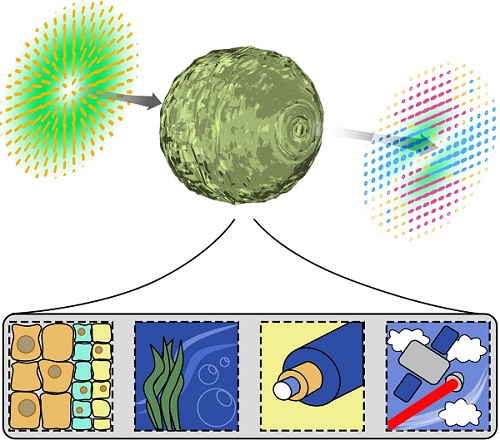A study conducted by researchers at the University of the Witwatersrand (Wits) and collaborators from Mexico, Scotland, and the University of Pretoria aims to explain the rules governing the complex light propagation in complex media — media that tends to distort light significantly. The team found that all such media can be treated in the same way, and that the analysis does not depend on the type of light used.
Previously, each choice of media and light beam were treated as a special. Additionally, they show that despite the distortion, there is a property of light that remains unchanged, invariant to the media — its “vectorness.”

An artistic impression of complex vectorial light passing through some distorting complex media and becoming altered in some way. The pattern of the light depicts the polarization state. The complex media shown in the insets includes living tissue, under water, optical fiber, and transmission through the atmosphere. Courtesy of Wits University.
“What we’ve found is that the vectorness is the single attribute of light that does not alter when passing through any complex media,” said Andrew Forbes, a professor at the University of the Witwatersrand School of Physics. “This means we have something special that can be exploited when using light for communications or sensing.”
Light’s vectorness is the variability of the direction of its electric field; it is a measure of how similar the directions of the electric fields of light are at different places. If it’s homogenous, the value is 0. If it’s inhomogenous, the value is 1. This vectorial homogeneity never changes, even if the pattern of the electric field itself changes. The reason is embedded in quantum entangled states
“This is a particular aspect of the pattern of the light — how the polarization pattern looks,” Forbes said. He said that while the pattern is also distorted, its intrinsic nature, of homogenous or inhomogenous, is not distorted.
The team’s approach allowed researchers to identify how to correct any distortions through the media in a way that avoids loss. “We show that even though the light is very distorted, the distortion is only a matter of perspective,” Forbes said. “One can view the light in such a way that it regains its original ‘undistorted’ properties. It is remarkable that complex light in complex media can be universally understood from very simple rules.”
For instance, by simply changing how a measurement is made, any communications through a very distorted media can be made “distortion free.”
The researchers demonstrated this experimentally through a range of systems, from turbulence to liquid or optical fiber.
Even through nonideal optical systems, which are crucial in applications such as imaging and optical communication across noisy channels, the approach paves the way to the versatile application of vectorial structured light, the researchers said.
The research was published in Nature Photonics (www.doi.org/10.1038/s41566-022-01023-w).